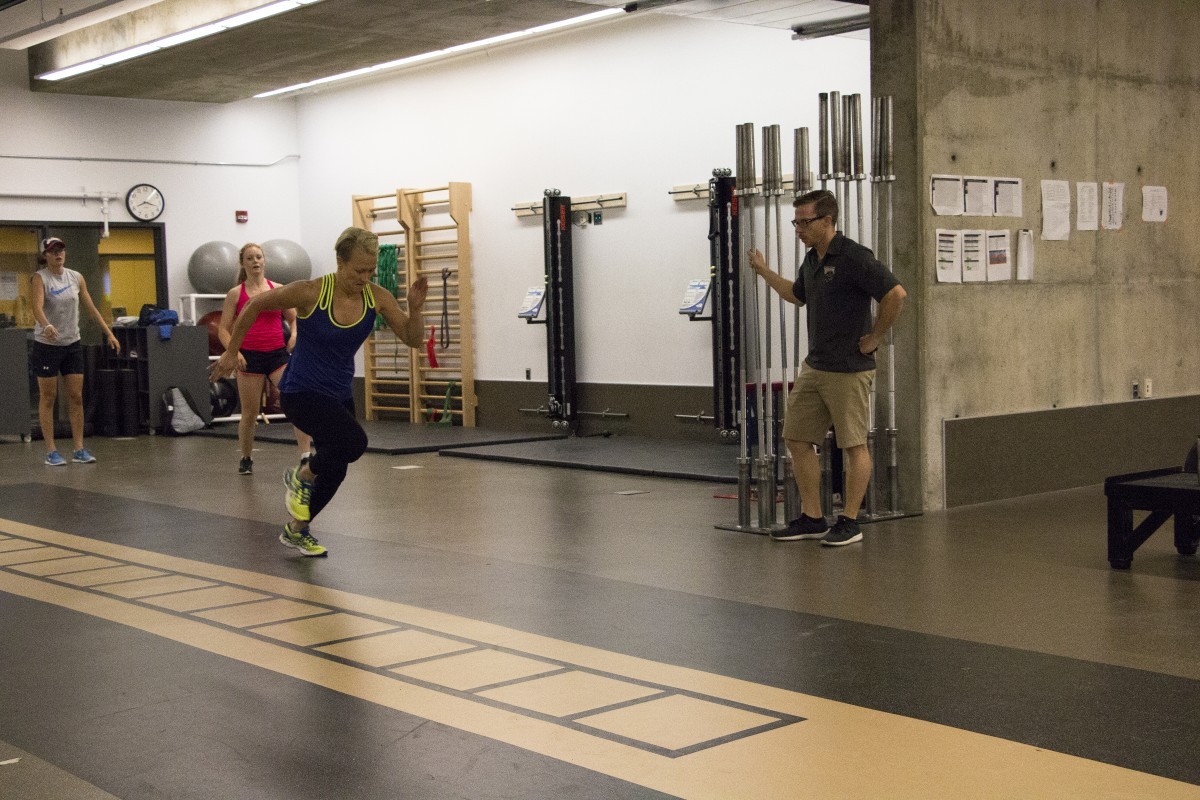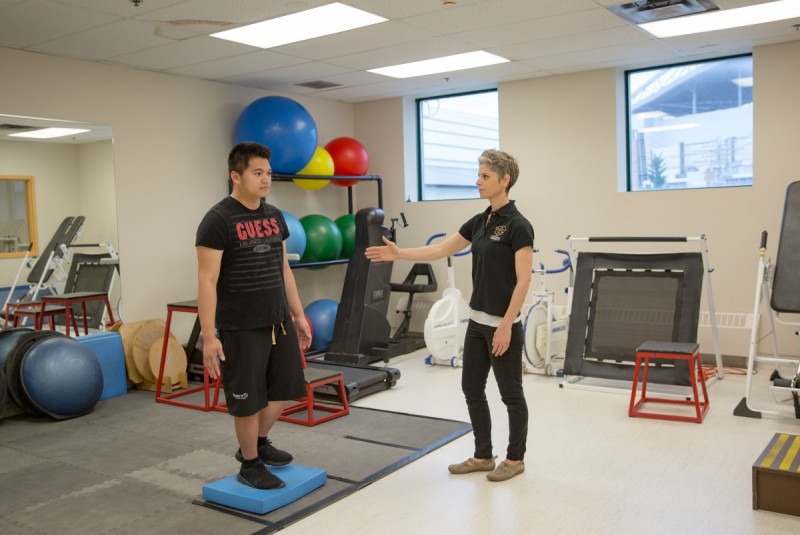
Bisons Hockey forward Venla Hovi sprinting under the watchful eye of head strength & conditioning coach, Shawn Preston.
Keeping Bison athletes strong & healthy
Atheltic therapy, strength and conditioning all part of a winning equation on and off the field
Originally published for the 2016-17 Bison Sports Magazine.
It’s a Wednesday in July and the sun has been up just shy of 90 minutes. Inside the U of M’s High Performance Training Centre, a handful of Bison athletes are stretching, methodically turning and twisting their bodies. This is only the warm-up. To the untrained eye, however, it looks like a training session on to itself.
That’s because everyone here is focused on details. Even the tiniest ones. There’s not a wasted movement happening right now. Even in stretching, every motion has a purpose. This focus starts from the top down, a hierarchical trickle effect.
Setting this tone is Bison Sports’ Head Strength and Conditioning Coach, Shawn Preston. He’s here today. He’s here pretty much everyday, actually. Preston’s currently observing the athletes as they go through a brief, powerful series of warm-up calisthenics to, in his words, “get the body moving.” He watches their movements (even in the warm-up) the same way a wise jeweller would analyze the ridges of a rare gem.
“A big reason why we pay so much attention to the technical component of how the athletes move is so that they’re capable of moving in proficient and efficient ways. And with that it’s going to help them decrease their injury rates,” he says.
“When we’re lifting weights here, we want them to lift them correctly so they’re not putting stress on joints and on the body in ways it’s not supposed to be done. We’re trying to make them stronger, not stress their bodies.”
Preston is in this role for a reason. He has more than a decade’s worth of experience in this field, working expertly in long-term athlete development and preparation of elite international athletes. He works directly with the Bison sports teams, and in the past has also been contracted with several national level organizations including the Canadian Sport Institute, Tae Kwon Do, Boxing, and Judo for the Chinese Olympic Committee, Snowboard Canada, Rugby Canada, Alberta Alpine, and the Hockey Canada Development Program.
It isn’t hard to connect the dots with what a place with the words “high performance” in it is trying to accomplish. Of course, increased strength, power, speed, agility, and any other training buzzword you can think of are indeed significant goals here. But injury prevention is what rules the roost.
“If we don’t make that our top goal, we’re kind of missing out on the whole concept of increasing the rate of play that the athlete can take place in,” Preston says.
“Keeping them healthy is an important factor in prepping the athletes for what the coaches need out of them.”
Today is rather humid, even for July in Winnipeg. A handful of Bison athletes are working on strength and explosiveness. Amongst the group is Bison’s hockey forward, and two-time Finnish Olympian, Venla Hovi.
She calls herself fortunate to have the High Performance Training Centre as a resource.
 “Everyday when I wake up I think about how lucky I am to work out here. It gives me a lot of motivation knowing that when I come here I get the best coaching and training possible,” she says.
“Everyday when I wake up I think about how lucky I am to work out here. It gives me a lot of motivation knowing that when I come here I get the best coaching and training possible,” she says.
From a strength standpoint, Hovi, who earned a bronze medal in the 2010 Vancouver Winter Olympic games, considers herself to be in the best shape of her life.
“Oh yeah,” she blurts out before the question is even finished. “My results keep going up since I’ve started. I feel very healthy and strong.”
While she prefers not to think too far ahead, Hovi’s confident her body will be in tip-top shape for the grind that is the Canada West hockey season—a season that last year saw the women’s Bison hockey squad make the Canada West finals.
“My goal, really, is to be in the best shape possible for when the real games start.”
Getting the athletes stronger and faster isn’t just about having them lift heavier and run longer. There’s a scientific approach to it all. Spreadsheets and computer read-outs brimming with performance data are poured over and expertly analyzed by Preston and his staff. It’s a way to efficiently evaluate what an athlete needs to work on, and to monitor progress. Doing it this way, Preston says, represents a bit of a culture change.
“What we’re trying to do now is to have athletes and coaches understand that it’s not just the grunt work you do in the weight room, but doing it in a scientific manner and where we monitor and make sure we are tracking and getting better is huge for using new technology we have available to us.”
“If we didn’t have these numbers and stats, then improvement is really a guessing game. The only numbers they would have to go on are their in-game statistics. If they’re a player that’s not playing in year one or year two because they’re younger or not being utilized, then there’s really no real number to go off of to see the progress in those earlier years.”
In the world of athletic maintenance and preparation, strength and conditioning are parts of a complicated equation. Bison athletes have another equally valuable (and crucial) resource available to them: athletic therapy, or AT.
In general, ATs deal with injuries, rehabilitation, and injury prevention so athletes can return to play as quickly and efficiently as possible. Specifically, however, the world of AT is so much more.
The Bison Athletic Therapy Centre (BATC), while physically located on campus in the Investors Group Athletic Centre, also has a presence in the field with Bison sports teams. Between two-to-six AT students are assigned to each team, monitoring and caring for athletes and consulting with coaches before, during, and after games and practices.

The Bison Athletic Therapy Clinic, located right on campus, isn’t just for athletes. Staff and students are more than welcome and encouraged to make appointments for athletic and massage therapy.
This duality, having both an AT clinic and dedicated team of student ATs, is instrumental to the unique and elite care offered to Bison athletes.
“We’re right on the front lines,” says Byron Bahniuk, a senior athletic therapist in the BATC. “We can see the injury occur, we can assess it, we can treat the acute component of it, and then we can bring the athlete into the clinic and do the other half of it.”
The other half of it involves in-clinic evaluation, rehabilitation, and education on preventative measures to avoid re-injury. It also involves a little bit of sport psychology. Bahniuk says it’s all a process.
“Once the athlete is healed, it’s our job to prove to them that they’re good to go. We’ll have them perform sport-specific type of movements needed for their sport, and we show them in a stage format that they can do these activities. Once we’ve shown them they can do it, their confidence starts to grow.”
The BATC offers such services as therapeutic ultrasound, laser therapy, postural education and reconditioning, custom orthotics, functional movement screening, and massage therapy, amongst a whole host of other therapeutic options for everyone … not just athletes.
“Everyone’s an athlete,” Bahniuk states. “Whether you’re what we call an industrial athlete (people who work in warehouses, assembly lines), doing very physical work, they can get injured. You also have the ‘weekend warriors’ that are playing sports. We deal with everyone.”






